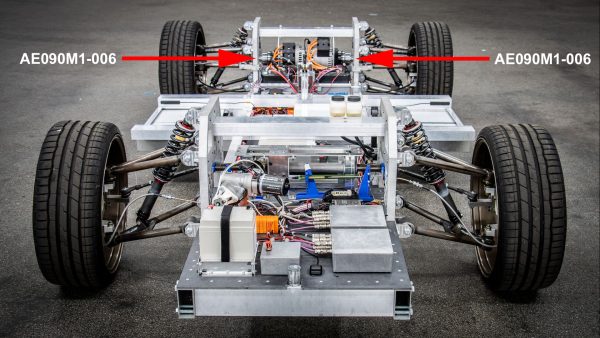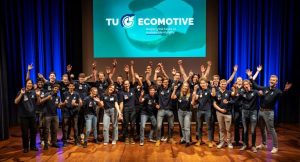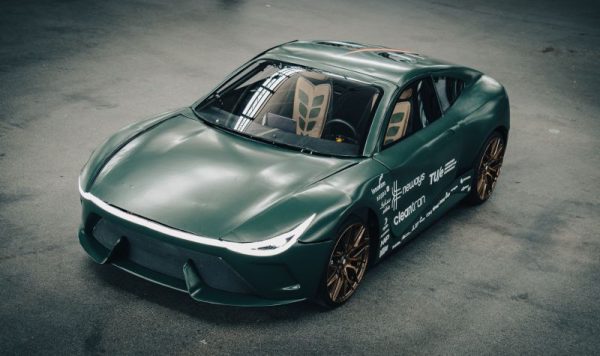TU/ecomotive builds ‘Car that lasts a lifetime’
What is the most sustainable car? TU/ecomotive is already thinking about an electric future and sets itself the goal of making mobility even more sustainable. Their solution: producing cars in a more sustainable way, which doubles their lifespan! A challenging task, and the team asked for the help of market parties in the development of their concept car. This aligns well with the mission of Apex Dynamics, and we were quickly convinced. In this article, we will discuss the mission of the student team and how they use a gearbox from the AE series in their drivetrain.
“Apex Dynamics wants to contribute to moving the world forward, which is why our slogan is ‘Move Forward’,” says Thom van Oss, Managing Director of Apex Dynamics BV. “Supporting student initiatives is an essential part of this mission. They come up with solutions for tomorrow’s challenges, and with our support, we inspire young people to pursue careers in technology. It’s a perfect match. The project of TU/ecomotive also aligns well with these goals.”

Apex Dynamics provided the student team with two gearboxes from the AE series and an accompanying mounting plate. Additionally, we are ready to offer our knowledge and experience to answer any questions they may have. In this way, we contribute a small part to their success.
TU/ecomotive builds ‘Car that lasts a lifetime’
Hugo van Hees, Business Manager at TU/ecomotive, explains the team’s mission:
In the past ten years, TU/ecomotive has evolved from a simple energy-efficient car to one of the most ambitious sustainable concept cars of our time with ZEM, the car that captures CO2. Today, the team is actively working on the next step in our journey. We are not only building upon the achievements of previous generations but also envisioning a future where climate-positive mobility is accessible to everyone. Our focus is on creating solutions that contribute positively to the environment and make a significant impact on the way we move and commute.
Currently, the mobility sector is embarking on the path of electrification to reduce global emissions (European Environment Agency, 2022). Out with emissions, and onward to an electric future. This brings us much closer to a climate-neutral future. However, electrification also brings about a whole set of new challenges. In a world reliant on electric mobility and a green energy mix, most emissions stem from material production. By 2040, this could even account for 60% of total automotive emissions (Hannon et al., 2020). So, has the team found a new sustainable way to produce cars? Not exactly. They have focused on something much simpler—extending the usage phase of cars. If you drive this car for 200,000 kilometers instead of 100,000 kilometers, you can halve the emissions per kilometer. Therefore, driving longer proves to be beneficial in reducing overall emissions.
But how did we do this?
Electric cars require very little maintenance, especially compared to combustion engines. Electric motors have far fewer components, and experts also expect batteries to last much longer than the cars themselves (Jerew, 2021) (National Grid-Group PLC, 2021). On the other hand, interior components such as upholstery tend to wear out or get damaged faster (Westbrook, 2019). Additionally, safety systems like cameras and sensors require new versions and features. This creates a significant gap in the lifespans of different components. That’s precisely where the idea comes into play! Why not separate the lifecycles? The lower part, the modular board, contains systems with long lifespans, such as the drive, batteries, and steering system. Meanwhile, systems with shorter lifespans are placed on the modular top at the top. This way, lifecycles can be separated from each other. Instead of replacing the entire car, you can replace only the top part of your car. This significantly reduces material production. In our car, the modular top can be separated from our modular board.
Three cars in one year? No problem!
Since building three cars in one year is beyond our capacity, the other iterations on the modular board will be created using “augmented reality.” This allows TU/ecomotive to showcase the entire lifecycle of the car while adapting it to the user’s preferences. The team will present this car during a tour throughout Europe this year. Throughout the tour, they will share their experiences and explain how they hope their vehicle will contribute to climate-positive mobility for everyone, taking a step towards a more sustainable future.
Why Apex Dynamics?
As previously explained, the bottom part of the car needs to have a long lifespan. To meet this requirement, the team opted for Taiwanese parts instead of Chinese ones due to their minimal clearance and high quality. Ensuring minimal clearance for all moving components was a strict requirement to maximize the lifespan of the car. The vehicle required a gear ratio of 1:6 to provide sufficient output torque from the drivetrain to drive the car.
With our car using rear-wheel drive and two motors, one for each driven wheel, the available space for a transmission was limited. Therefore, the team sought a planetary gearbox as they are highly compact. Since we are developing a concept car, the motor will not run at high speeds, which made the AE series from Apex Dynamics a suitable choice. The AE090 gearbox was compact enough to fit into the available space, had the right gear ratio, and was relatively lightweight. Two AE090 gearboxes are now used in Eterna, one for each motor, and they are attached to the motors via a mounting plate also supplied by Apex Dynamics.
If you wish to follow TU/ecomotive or contribute to the team’s mission, visit the TU/ecomotive website.






